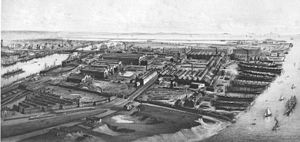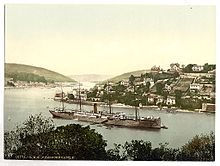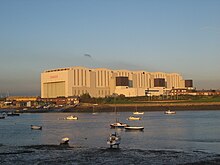Barrow Shipbuilding Company
The Barrow Shipbuilding Company was a shipbuilding company in Barrow-in-Furness and existed from 1871 to 1897. Barrow Shipbuilding was considered a pioneer in the construction of submarines.
history
The preparatory work for the construction of the shipyard began in 1867 on Barrow Island. The company was founded in 1871 as the Barrow Iron Shipbuilding Company with substantial participation from shareholders of the Furness Railway Company and in the following year as Barrow Shipbuilding Company Ltd. renamed. The first ship, the steam yacht Aries , was launched on May 12, 1873 for co-founder Sir James Ramsden. The D. & W. Henderson & Company shipyard helped build the first ships, and over a hundred ships were built over the next ten years, including warships and large passenger ships. The City of Rome (8,415 GRT), built in 1881 for the Inman Line , was the second largest ship in the world after the Great Eastern (18,915 GRT). In 1886 they broke new ground with the construction of the Nordenfelt submarine . In 1888 the Barrow Shipbuilding Company acquired the Maxim Nordenfelt Guns and Ammunition Company and renamed the company Naval Construction and Armaments Company Ltd. and went into the ship weapon industry. In 1897 the Naval Construction and Armaments Company was in turn taken over by Vickers, Sons and Company and renamed Vickers, Sons and Maxim Ltd. renamed. With the acquisition of the shipyard in Barrow-in-Furness, the Vickers Group, which until then had only worked as a shipbuilding supplier and weapons manufacturer, was able to offer entire ships for the first time. In 1901 and 1902, Vickers-Maxim built the first submarine commissioned by the British Navy, the Holland 1 .
The name of the umbrella company was changed to Vickers Ltd. in 1911. and the shipyard in Barrow-In-Furness was renamed Naval Construction Yard (Vickers) . During the First World War, 35 surface warships and 132 submarines were built in Barrow. In 1927, the parent company Vickers merged with Armstrong-Whitworth to form Vickers-Armstrongs , whereupon the joint shipbuilding activities under the name Vickers-Armstrongs (Shipbuilders) Ltd. were summarized. In 1955 the name of the shipbuilding division changed slightly to Vickers Armstrongs Shipbuilders, Ltd. and in 1968 again in Vickers Limited Shipbuilding Group.
After the umbrella company was nationalized in 1977 and incorporated into British Shipbuilders , it was privatized as the first company of the state group on July 25, 1984 under the government of Margaret Thatcher. In March 1986, the company, now known as Vickers Shipbuilding and Engineering Limited (VSEL), went to the employee-led VSEL consortium together with Cammell Laird .
In 1994, both General Electric Company (GEC) and British Aerospace submitted bids to acquire VSEL. The Monopolies and Mergers Commission (MMC) examined both bids, rejected the GEC and voted for British Aerospace. Nevertheless, the GEC was awarded the contract and the group operated as Marconi Marine (VSEL) within the GEC-Marconi division. In 1999 GEC-Marconi (Marconi Electronic Systems) and British Aerospace merged to form BAE Systems. Marconi Marine (VSEL) was integrated into the shipbuilding division of BAE Systems Marine. In 2003 BAE Systems Marine was split up into the respective independent subcontractors BAE Systems Submarines , based in Barrow-in-Furness, and BAE Systems Naval Ships, based in Glasgow. BAE Systems Submarines was renamed BAE Systems Submarine Solutions in 2007 and BAE Systems Maritime - Submarines in 2012 .
literature
- Middlemiss, Norman L .: British Shipbuilding Yards . Volume 3: Belfast, Merseyside, Barrow and All Other Areas. 1st edition. Shield Publications, Newcastle-upon-Tyne 1995, ISBN 1-871128-12-9 .
Web links
- Entry in Grace's Guide (English)
- Entry at Recruitment Cumbria (English)


